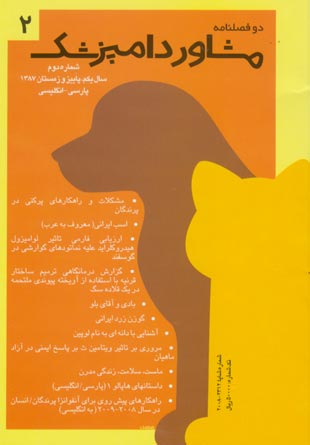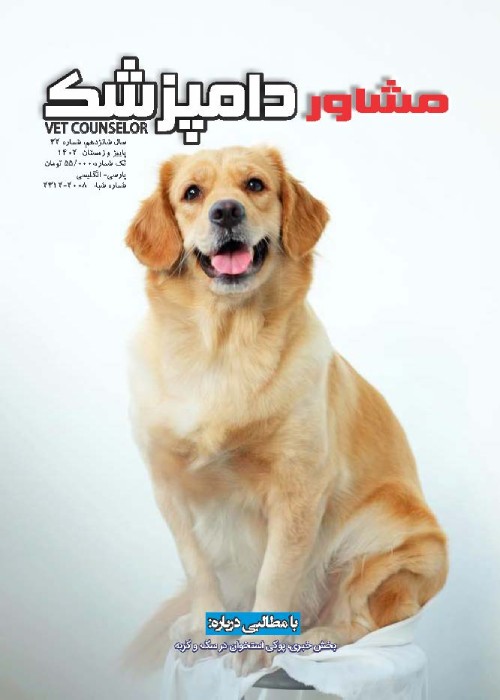فهرست مطالب

دو فصلنامه مشاور دامپزشک
پیاپی 2 (پاییز و زمستان 1387)
- 154 صفحه، بهای روی جلد: 50,000ريال
- تاریخ انتشار: 1387/11/15
- تعداد عناوین: 12
-
صفحه 1
-
صفحه 13
-
صفحه 29
-
صفحه 67
-
صفحه 101
-
صفحه 111
-
Page 13Feather Plucking is When the birds completely remove the feather by pulling it out at the base of the Shaft, There is no doubt that feather plucking is one of the leading reasons that captive pet birds are brought to the veterinarian.The Possible etiologies for feather plucking will be medical condition or physical condition.Some diseases like; Bacterial, fungal or virus disease, Allergies, endocrine diseases, ecto or endo parasite, internal tumor, kidney diseases are the medical conditions.The Physical condition; Injury or trauma, dry skin, lack of exercise and ect.Treatment: Provide plenty of toys, occupy your bird’s time by Encourage to find food, sleep 10 to 12 hour each night, using some drugs like: Diazepam, haloperidol, Fluoxetin, and HCG.
-
Page 29Persian (Arabian) horse is well known for its strength, all over the world. The place of its origin and the real name is not been known yet and It is in doubt, although it is said that its antiquity is anywhere between 5000 B.C and 2500 B.C. Many researches showthat from the start, Persian horse was nurtured in parts that are now known as Iran, Syria, Iraq, and in other parts of the Middle East area.Broad forehead, arched neck, well laid-back shoulder and a compact body with a short back are the most important charters of this breed. Because of its remarkable charactheristics, it has been distributed around the world very fast and now a days we can see different famous breeds with Arabian horse heritage in countries like America, Canada, European countries, Russia and other countries.
-
Page 39
In the present survey the efficacy of injectable Levamisol hydrochloride was evaluated in two sheep farms in the Gilan province. In addition, 10 sheep (4 and 6 sheep as control and case respectively) were examined. Each two groups were naturally infected with lung and alimentary tract nematodes and were treated according to their individual with the dose recommended by the manufacture (1ml/ 10kg BW).The feces samples were extracted directly from the rectum of each animal and stored in labelled plastic bags. Eggs per gram (EPG) were performed for each sample by the flotation method at 0, 4, 7, 14 days post-treatment following after treatment. Fifteen days after the treatment 10 sheep were slaughtered for worm recovery and determined species of helminthes in the case and control groups for each animal. The mean of EPG were 170-350 in hospital groups and 346-390 in farm groups. The mean EPG value at 14 days posttreatment was 0-2.5 in farms group. The mean EPG value at hospital group was 0 and 430 at 14 day post- treatment in case and control groups respectively. In count and identification of adult stages after carrying out the necropsied at the 15 day post-treatment not helminth observed in the case group (6 sheep) while in controlgroup (4 sheep) had different nematodes in alimentary canal including: Haemonchus contortus (300, in two sheep), Ostertagia spp. (250, in two sheep), Trichostrongylus spp.(250, in two sheep) and lung: Dictyocaulus filaria (15, in two sheep).The results of this survey shows an efficacy of 100% for injectable levacid against adult nematodes of lung and alimentary canal in sheep.
-
Page 49Corneal ulceration is a common and important condition in domestic animals. One of the most common causes is trauma. Regard to histologic structure of cornea, losing of epithelial and stroma result in descematocele, perforation and iris prolapse. Thepresent clinical report is about surgical treatment of descematocele with corneal perforation in one dog. A four-year-old casterated shih-zu dog was referred with pain, belpharospasm, epiphoria, keratitis ulceration, descematocele and perforation of cornea.Fluorescein stain showed deep ulcer of cornea. No lens dislocation, retinal detachment, anterior and posterior synechiae were seen, but diameter of anterior chamber was reduced obviously in ultrasonographic survey. Immediate medical treatment wasperformed with Atropine sulfate (ocular agent) and antibiotics (ocular and systemic agents). Pre-operative preparation of patient and surgical team were performed. Then surgical treatment was carried out using conjuctival pedicle grafting. Post-operative care was performed routinely. Clinical examination of cornea revealed acceptable healing at end of eight weeks.
-
Page 59The Strong bond that often develops between humans and animals is obvious, but the connection that can unite animals to one another sometimes isn’t as clear. Nonetheless such ties exist and sometimes are revealed in bizarre ways.Jack and Ida Monroe had a lively cocker Spaniel, Buddy, for three years before the brought Mr. Blue (an 8 –week – old) spaniel mix. Each dog had “chores” to do on the Monroe’s Lemon Ranch. The Monroes relocated to the San Joaquin Valley of Californiain 1956. Buddy was 11 Years old totally blind and deaf. Once they were settled in their new home, Buddy and Mr. Blue, too, adapted quickly to the new Surroundings.One afternoon, however, Mr. Blue didn’t come home from playing. Ida Saddled her horse and went searching for her spaniel in the fields but the dog didn’t show up. Ida returned home. She was growing more anxious. Suddenly, Buddy wanted out. Buddy knewright where he wanted to go. He just pulled on the leash and headed down the rood. Suddenly he veered to the left and on to an abandoned farm.
-
Page 67The Persian fallow deer is the largest of the fallow deer, weighing 40 - 100 kg. It occupies woodland habitat. The diet of fallow deer varies by season and includes grass, nuts and leaves. Fallow deer live in herds, with males establishing territories duringthe breeding season. The Persian fallow deer previously occurred in North Africafrom the Tunisian border to the Red Sea and in Asia from Syria and Jordan to Iraq and western Iran. It was hunted to extinction over most of its range, with the advent of modern firearms having accelerating this process. By 1951 it was thought to have becomeextinct, but in 1955 limited number were found in a dense forested region in Iran, near the border with Iraq. This population persisted despite continued hunting and habitat destruction at least until the 1980's. Recently, conflict between Iran and Iraq has made itdifficult to determine the deer's status.
-
Page 79Lupin has been cultivated for at least 2,000 years, and probably was first raised in Egypt, or at least in the general Mediterranean region.The lupin plant, like other grain legumes (beans, peas, lentils), fixes atmospheric nitrogen and produces seed high in protein. Of the more than 300 species of the genus Lupinus are existed, while only five are cultivated. Many lupins have high levels of alkaloids(bitter tasting compounds) that make the seed unpalatable and sometimes toxic.Historically, lupin alkaloids have been removed from the seed by soaking. But German plant breeders in the 1920s produced the first selections of alkaloid-free or "sweet" lupin, which can be directly consumed by humans or livestock.
-
Page 85Due to the lack of L-gulonolactone oxidase enzyme, most fish species are unable to synthesize vitamin C (ascorbic acid) in sufficient quantity to meet metabolic needs, and thus have a requirement for this vitamin. Deficiency symptoms reported arestructural deformities, impaired collagen synthesis, decreased alkaline phosphatase activity, anemia, low tissue level of ascorbic acid, anorexia, growth retardation; poor feed efficiency, and delayed wound healing. The requirement of vitamin C by fish toprevent these deficiency signs rangs from 11 to about 100 mg/Kg of diet. Vitamin C has also been shown to influence immunity and disease resistance in fish. The immune system consists of innate (natural) and acquired (specific) immune mechanisms as have beenreported for terrestrial animals. Published information appears to indicate that a deficiency in ascorbic acid in immuno suppressive, and animals fed ascorbic acid-deficient diets are more susceptible to infectious disease than those fed vitamin C replete diets. However,evidence on the role of ascorbic acid in improving the immune response and disease resistance in fish is not consistent, although numerous studies have indicated that feeding fish ascorbic acid at levels higher than those required for normal growth and preventionof deficiency signs enhanced their immune response and resistanceagainst bacterial infection. Without clear evidence on the beneficial effect of high levels of ascorbic acid on the immune response and disease resistance, feeding fish vitamin C at a level sufficient tomeet their requirement for growth and prevention of deficiency signs is suggested.
-
Page 101Yogurt (also spelled yogourt or yoghurt) is a semi-solid fermented milk product which originated centuries ago in historical civilizations (for example in Iran). It's popularity has grown and it is now consumed in most parts of the world.Although the consistency, flavour and aroma may vary from one region to another, the basic ingredients and manufacturing are essentially consistent. Fermentation of the lactose (by several micro organism, for example Lactobacillus) produces lactic acid, which acts on milk protein to give yoghurt its texture and its characteristic tang.Such healthy natural food is nutritionally rich in protein, calcium, riboflavin, vitamin B6 and vitamin B12. Many investigators have studied the therapeutic and preventive effects of yogurt and lactic acid bacteria, which are commonly used in yogurt production, on diseases such as cancer, infection, gastrointestinal disorders, asthma' hypersensitivity and autoimmune disorders that are the most important problems in modern life.
-
Page 111The story of Hapaloo is the story of a dog that was born in a dark and dingy crypt, and ended up in a wealthy house and finally found an owner. Hapaloo is a fiction which glances at human twofold characteristics, when human descends to the lowest, and when he ascends to be the superior of the creatures. The story pictures a twofold encounter between human beings and god’s creatures. In essence, Hapaloo is an indicator of human beings evolution. This story, depicts the value that Iranians attach to animals, moreover; it familiarizes the readers with domestic animal diseases. Hapaloo is alovely and imaginary character which value veterinary. It was the longest night of the year, Yalda night, when some nations especially Iranians celebrate. It was cold. Jackie was a six and half year old dog who was in her second month of pregnancy.


